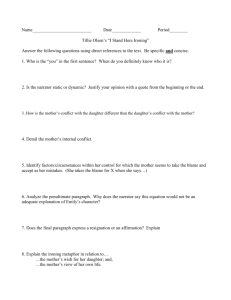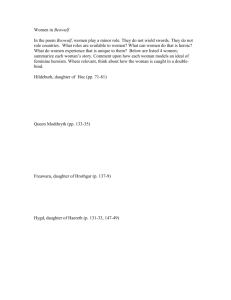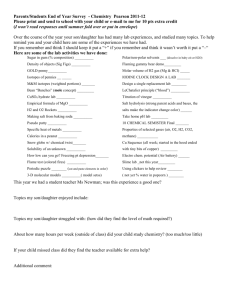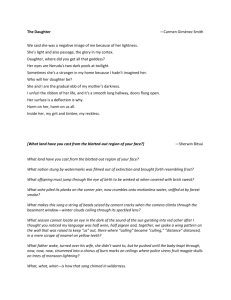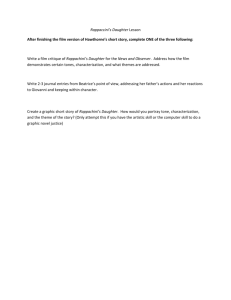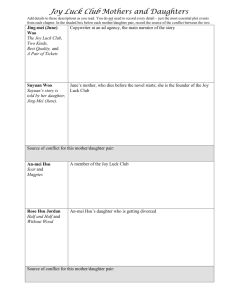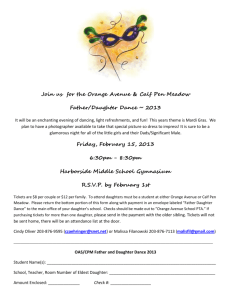Family Matters - The University of Michigan Press
advertisement
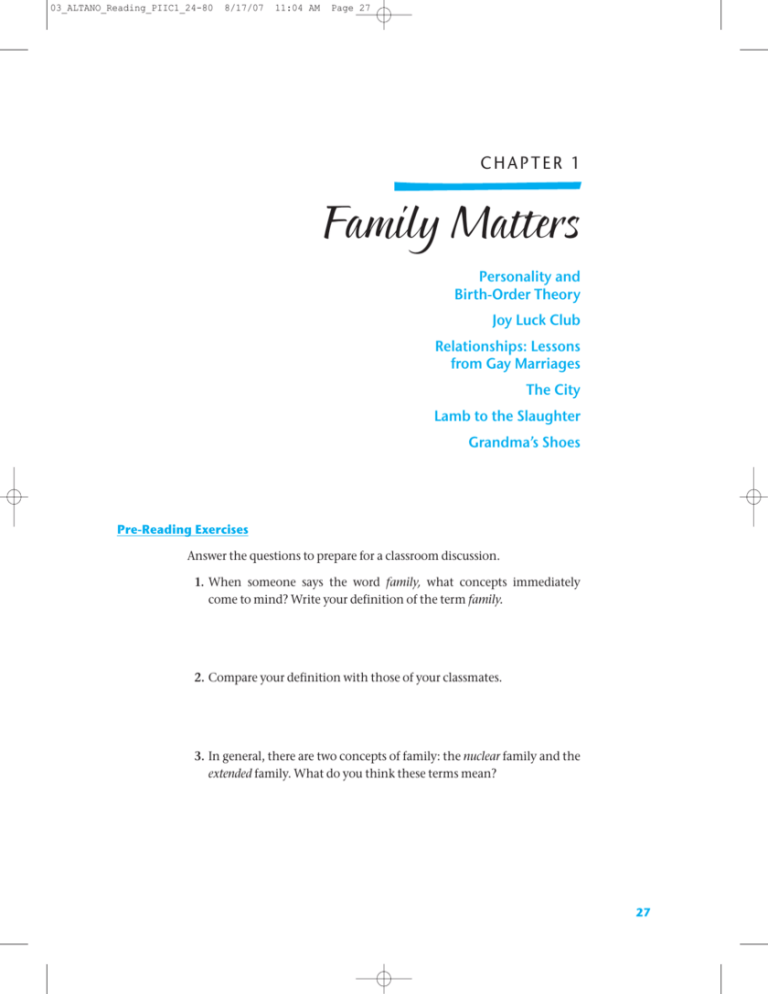
03_ALTANO_Reading_PIIC1_24-80 8/17/07 11:04 AM Page 27 CHAPTER 1 Family Matters Personality and Birth-Order Theory Joy Luck Club Relationships: Lessons from Gay Marriages The City Lamb to the Slaughter Grandma’s Shoes Pre-Reading Exercises Answer the questions to prepare for a classroom discussion. 1. When someone says the word family, what concepts immediately come to mind? Write your definition of the term family. 2. Compare your definition with those of your classmates. 3. In general, there are two concepts of family: the nuclear family and the extended family. What do you think these terms mean? 27 03_ALTANO_Reading_PIIC1_24-80 8/17/07 11:04 AM Page 28 The nuclear family is the basic family unit. In traditional families, it is composed of the husband and wife (who then become father and mother) and the children. It might also include the grandparents. The nuclear family usually lives together in one house. An extended family, on the other hand, is much larger and encompasses cousins, aunts, uncles, and in-laws (relatives acquired through marriage). Family reunions, which are becoming more popular in America as extended families branch further and further away from each other geographically, are occasions to bring together family members. 4. Was your concept of family in Question 1 based on a nuclear family or an extended family? As we said, traditional nuclear families usually live in the same house. However, since divorce now occurs in more than 50 percent of American marriages, and since re-marriage is quite common, it may well be that the basic family unit is much more complicated. The concepts of step and half have been introduced into the mix. There are stepmothers, stepfathers, stepdaughters, and stepsons. In addition, there are half-brothers and halfsisters (the siblings inherited when a re-marriage takes place). Furthermore, with movements toward gay marriages gaining momentum in the United States, the traditional concepts of couples, partners, spouses, parents, and guardians are changing. 5. Would you consider your particular family situation to be traditional or non-traditional? Why? Ideally, families are the source of love and nurture, the rock foundation on which we base our lives, a fixed concept in a changing world. However, sometimes family members hurt each other and become estranged. There is also sibling rivalry (a competition for success and affection between brothers and sisters). 6. There is an old song that goes, “You only hurt the one you love.” What do you think these lines mean? Do you think they are true? 28 part two • the reading units 03_ALTANO_Reading_PIIC1_24-80 8/17/07 11:04 AM Page 29 7. How do close relatives become estranged? How do sisters and brothers, who grew up together, get to the point where they don’t even talk? At wedding receptions, one of the tasks of the happy bride and groom is to organize their relatives into tables of eight or ten (eight or ten seats at a round table—the tables are round so that there is no “head” where the most important person sits). This is sometimes a difficult task because Aunt Sallie doesn’t talk to Aunt Rose. The bride’s sister and her cousin can’t stand each other. The groom’s grandfather hasn’t spoken to his brother in twelve years. 8. Are there people in your family who don’t talk to each other? What brought this situation about? his chapter focuses on family matters, the myriad relationships that form the basis of nuclear and extended families. There is a passage about different personalities based on the order of birth (the oldest, only child, middle child, and the youngest), an analysis of the intricate mother-daughter relationship, and an article explaining why the divorce rate among gay couples is lower than that of heterosexuals. You will find a love poem written for Valentine’s Day from a wife to her husband and a short story that tells of interesting behavior on the part of a wife whose husband shocks her with terrible news. Finally, there is a humorous story about a funeral in which a grandson saves some money by buying cheap shoes that are much too big for his recently deceased grandmother, thus ruining her plans to be the most beautiful dead person in the family. T chapter 1 • family matters 29 03_ALTANO_Reading_PIIC1_24-80 8/17/07 11:04 AM Page 30 UNIT 1.1 Personality and Birth-Order Theory According to the sociological and psychological concept of birth-order theory, every birth position in the family is special in its own way. Children in all families are treated diversely and develop different personalities depending on whether they are the oldest, youngest, middle, or only children. Within each group, though, members generally share similar characteristics. First-Born Children First-borns usually identify with their parents’ sense of values more readily than other children. In general, they are more conservative and traditional and demand more of themselves. They attempt to excel in everything they do and have high standards, which they apply to themselves and also to others. As children, they are often asked to assume responsibilities far beyond their age; for example, they might be asked to take care of their younger siblings while their parents are out. Their constant effort to please their parents often encourages them to become high achievers and to succeed in high-pressure jobs and careers. They tend to function well in the academic, corporate, and professional fields. It is of note that more than 50 percent of all the presidents of the United States have been first-borns or first-born sons (the first male born in the family). (Even if a son isn’t the first child, but follows a firstborn daughter, he is considered a first-born son.) 30 part two • the reading units 03_ALTANO_Reading_PIIC1_24-80 8/17/07 11:04 AM Page 31 Only Children Only children share many of the same characteristics as first-borns; however, they often carry these traits to extremes. As opposed to first-borns, their parents’ admiration and undivided attention last throughout their entire lifetime. Their fear of disappointing their parents can be transformed into an unending effort to be perfect. As a result of their upbringing, only children may be well organized, super reliable, and sensitive to adult needs. On the other hand, their parents’ over-indulgence can turn only children into selfish, dependent, and spoiled brats. Only children are often quite mature and responsible for their age. In general, they are self-sufficient, enjoy privacy a great deal, and have a high sense of self-esteem. For this reason, they may have similar occupations or professions as first-borns. Twenty-one out of the first 23 U.S. astronauts were the oldest or only children in their families. Middle Children Middle children are quite different from the other members of the family. Generally speaking, they look outside the family for approval and acceptance and are therefore more sociable and less traditional than other children. They try to obtain from their peers the attention their older brothers and sisters received from their parents. By finding their strength outside the family, they learn valuable skills that prepare them for adult life: diplomatic skills, the ability to listen and relate to others, and learning how to compromise and negotiate. It is no coincidence that many middle children assume managerial or leadership positions. Youngest Children The last component in birth order theory is the baby of the family. According to the theory, the youngest children can become real charmers, playful or manipulative in their attempt to get as much attention as possible. They develop strategies to make their presence felt, either by behaving disagreeably or by finding creative outlets such as drawing, writing, or sports. Do youngest children get away with murder? The youngest children’s parents are often older, more tired, or more relaxed about rules that had seemed essential with the other children. As a result, these children grow up experiencing fewer family pressures and much more independence. The outcome is a more creative and carefree person, which is why the youngest frequently select careers in the arts, entertainment, or sales. chapter 1 • family matters 31 03_ALTANO_Reading_PIIC1_24-80 8/17/07 11:04 AM Page 32 How can birth-order theory be applied to everyday life? Certainly, no one’s personality fits these descriptions exactly. However, birth-order theory can help people better understand themselves and can serve as a tool for self-improvement. Because it works in a majority of cases, it is a useful tool to understand personality. Reading Comprehension Short Answers Answer the questions in complete sentences. Use your own words as much as possible. 1. What is the result of the “constant effort to please their parents” for first-born children? 2. Why do middle children try to get attention from their peers? 3. Why do the youngest children have fewer family pressures? 4. What is the negative side of the personalities of only children? 5. Why do you think that astronauts are usually the oldest or only children in their families? Vocabulary in Context Highlight the vocabulary terms in the reading passage and try to figure out their meaning from context. Then, use a dictionary and provide the following information: (a) part of speech; (b) positive, negative, or neutral connotation (+, –, =); (c) any prefixes, suffixes, or roots that help you find the definition of the word; (d) the definition; and (e) a sentence using the word. 32 part two • the reading units 03_ALTANO_Reading_PIIC1_24-80 term 8/17/07 11:04 AM part of speech Page 33 connotation (+, –, =) roots, prefixes, or suffixes definition 1. values sentence: 2. excel sentence: 3. responsibilities sentence: 4. undivided sentence: 5. dependent sentence: chapter 1 • family matters 33 03_ALTANO_Reading_PIIC1_24-80 8/17/07 11:04 AM part of speech term Page 34 connotation (+, –, =) 6. spoiled sentence: 7. diplomatic sentence: 8. peers sentence: 9. compromise sentence: 10. “get away with murder” (idiomatic expression) sentence: 34 part two • the reading units roots, prefixes, or suffixes definition 03_ALTANO_Reading_PIIC1_24-80 8/17/07 11:04 AM Page 35 Vocabulary Analysis Synonyms Match each word with the best definition from the list. 1. values a. to be better than everyone else 2. responsibilities b. relying on others 3. excel c. equals 4. undivided d. avoid punishment for a bad action 5. dependent e. complete, full 6. spoiled f. standards of conduct 7. diplomatic g. things that you have to do 8. peers h. avoiding conflict 9. compromise i. given everything, expecting everything 10. get away with murder j. giving up something to reach agreement Text-Based Grammar Analyzing the Use of Discourse Markers A discourse marker is a transition word that indicates the direction the writing will take. For example, if we say, “He is rich, but . . .”, the word but indicates a different direction for the sentence. He is rich is a positive statement. The word but, though, indicates that the second part of the sentence will be negative. Learning to locate and understand discourse markers will help a great deal with reading comprehension. The author of “Personality and Birth-Order Theory” uses many discourse markers or connectors to introduce examples or points supporting the main ideas. In general, we may divide discourse markers into three categories: adding information, contrast, and result. Others are used to present examples. They are usually found at the beginning of the sentence and indicate the direction that it will take. chapter 1 • family matters 35 03_ALTANO_Reading_PIIC1_24-80 8/17/07 11:04 AM Page 36 Find as many discourse markers as you can in the passage, highlight or underline them, and write them, indicating their function. 1. though (Paragraph 1), used to indicate contrast 2. in general (Paragraph 2), used to make a generalization or present an example 3. 4. 5. 6. Text-Based Writing Assignment and Discussion Where are you in the birth order in your family? Do the characteristics presented in the article generally describe you? Do they describe your siblings? Write a description paragraph approximately 10–12 sentences long. Then be prepared to discuss these questions in class. Description of the Illustration Examine the illustration that accompanies “Personality and Birth-Order Theory.” What is going on in the illustration? What symbols does the illustrator use to present the message? 36 part two • the reading units 03_ALTANO_Reading_PIIC1_24-80 8/17/07 11:04 AM Page 37 UNIT 1.2 Joy Luck Club Amy Tan (1952– ) Amy Tan was born in Oakland, California, the daughter of two immigrants from China. She grew up in California and became a successful business writer after finishing San Jose State University with majors in English and linguistics. Her career was flourishing, but in 1987, her mother became very ill. Tan promised herself that if her mother recovered, she would take her back to China, which her mother had left on the last boat before the communist takeover in 1949. The trip to China, during which her mother’s tragic youthful experiences were revealed, became the source of a major work of fiction, Joy Luck Club, published in 1989. The book became an immediate success, remaining for more than eight months on the New York Times bestseller list and being translated into 17 languages. It is a book narrated by four mothers and their daughters and analyzes this complex relationship. This passage is an excerpt from Joy Luck Club in which one of the mothers, Ying-Ying St. Clair, talks about her relationship with her daughter Lena, revealing not only a generation gap, but also a cultural gap. ying-ying st. clair Waiting between the Trees My daughter has put me in the tiniest of rooms in her new house. “This is the guest bedroom,” Lena said in her proud American way. I smiled. But to Chinese ways of thinking, the guest bedroom is the best bedroom, where she and her husband sleep. I do not tell her this. Her wisdom is like a bottomless pond. You throw stones in and they sink into the darkness and dissolve. Her eyes looking back do not reflect anything. I think this to myself even though I love my daughter. She and I have shared the same body. There is a part of her mind that is part of mine. But when she was born, she sprang from me like a slippery fish, and has been swimming away ever since. All her life, I have watched her as though from another shore. And now I must tell her everything about my past. It is the only way to penetrate her skin and pull her to where she can be saved. This room has ceilings that slope toward the pillow of my bed. Its walls close in like a coffin. I should remind my daughter not to put any babies in this room. But I know she will not listen. She has already said she does not want any babies. She and her husband are too busy chapter 1 • family matters 37 03_ALTANO_Reading_PIIC1_24-80 8/17/07 11:04 AM Page 38 drawing places that someone else will build and someone else will live in. I cannot say the American word that she and her husband are. It is an ugly word. “Arty-tecky,” I once pronounced it to my sister-in-law. My daughter had laughed when she heard this. When she was a child, I should have slapped her more often for disrespect. But now it is too late. Now she and her husband give me money to add to my so-so security. So the burning feeling I have in my hand sometimes, I must pull it back into my heart and keep it inside. What good does it do to draw fancy buildings and then live in one that is useless? My daughter has money, but everything in her house is for looking, not even for good-looking. Look at this end table. It is heavy white marble on skinny black legs. A person must always think not to put a heavy bag on this table or it will break. The only thing that can sit on the table is a tall black vase. The vase is like a spider leg, so thin only one flower can be put in. If you shake the table, the vase and the flower will fall down. All around this house I see the signs. My daughter looks but does not see. This is a house that will break into pieces. How do I know? I have always known a thing before it happens. Source: Amy Tan, Joy Luck Club (New York: G. P. Putnam and Sons, 1989). True or False Write a T or an F to indicate whether the statement is true or false. If it is false, change it to make it true. 1. The narrator’s daughter is an architect. 2. The narrator is very comfortable in her daughter’s house. 3. The narrator loves the design of the house. 4. The relationship between mother and daughter is one of mutual love and affection. 5. The mother has the ability to understand the past clearly. 6. According to Chinese custom, the guest bedroom should be the best bedroom in the house. 7. Lena follows Chinese customs closely. 8. The shape of the mother’s bedroom is very comfortable. 38 part two • the reading units 03_ALTANO_Reading_PIIC1_24-80 8/17/07 11:04 AM Page 39 9. The mother will become a grandmother soon. 10. Lena has never gotten married. Reading Skills Making Inferences (Reading between the Lines) Choose the correct inference based on your understanding of the text. 1. The narrator: a. was probably very close to her daughter throughout her life b. probably became estranged from her daughter at some point c. was not close to her daughter from the very beginning 2. The reader can infer from the text that, according to the narrator, the best sort of daughter: a. is strong and independent b. is devoted to her mother and follows her mother’s wishes c. listens more to her father than her mother 3. The reader can infer that the mother brings up the marble table: a. to talk about the valuable things that her daughter has in her house b. to show that the house is for looking, not for living c. to show that her daughter has an excellent sense of style 4. The narrator feels differently from her daughter about the room where she sleeps because: a. she feels that she should have the best room in the house b. she is happy that her daughter has the best room in the house c. she doesn’t want to bother her daughter 5. It is probable that the mother’s reaction to her daughter’s career is: a. happiness because her daughter makes so much money b. bewilderment because her daughter designs beautiful houses for other people c. pride because her daughter has an excellent profession chapter 1 • family matters 39 03_ALTANO_Reading_PIIC1_24-80 8/17/07 11:04 AM Page 40 Reading Skills Understanding the Narrative Voice In a piece of fiction, the narrator is the person who tells the story. A firstperson narrator is one who tells his or her own story. Readers can identify first-person narrators immediately by noticing the pronoun I repeated in the passage. This type of narrator is also a character in the story. By reading the words of the narrator closely and carefully, attentive readers can find characteristics of the narrator. Readers can learn many things from the first-person narrator, and also many things about the narrator. Answer the questions by reading the narrator’s words carefully. Explain what clues helped you with your answer. The first one has been done for you. 1. b. Clues: 2. Chinese She finds it difficult to pronounce architect, so her native language is not English. She mentions “Chinese ways of thinking.” Her name is Ying-Ying. As a result, her native language is probably Chinese. a. What is the mother’s native language? a. What was the mother’s method of disciplining her daughter when she was young? b. Clues: 3. a. What is the mother’s opinions of her daughter’s sense of style? b. Clues: 40 part two • the reading units 03_ALTANO_Reading_PIIC1_24-80 8/17/07 4. 11:04 AM Page 41 a. What is the mother’s ability to write in English? b. Clues: 5. a. What was the mother’s past probably like (happy or sad, calm or tragic)? b. Clues: 6. a. What is the mother’s opinion of the host/guest relationship? b. Clues: 7. a. What is her daughter’s opinion of the host/guest relationship? b. Clues: 8. a. What is the mother’s economic situation? b. Clues: chapter 1 • family matters 41 03_ALTANO_Reading_PIIC1_24-80 8/17/07 9. 11:04 AM Page 42 a. What is the mother’s special ability? b. Clues: 10. a. What is obviously true of the man who the mother married? b. Clues: Vocabulary Development Combining Forms (Prefixes, Suffixes, Stems) In the excerpt from Joy Luck Club, Amy Tan uses the word bottomless. This word is made up of two combining forms, both common in English: the stem bottom and the suffix -less, which means “without.” We can use bottom as a combining form, followed by a noun. My sister lives on the bottom floor of a tall building. The black fish in the aquarium is a bottom dweller. Similarly, we can take a noun, combine it with the suffix -less, and produce an adjective. Carlo is really helpless. I think the game is hopeless. We are already losing 28–0, and it’s only halftime. Work together with a partner to create lists. 1. Make a list of words that can follow bottom: 42 1. 3. 2. 4. part two • the reading units 03_ALTANO_Reading_PIIC1_24-80 8/17/07 11:04 AM Page 43 2. Make a list of words that end in -less: 1. 4. 2. 5. 3. 6. 3. The passage from Joy Luck Club discusses the relationship between a mother and a daughter. The Latin word for mother (mater, matri) has become a prefix in English. Analyze the following terms and try to guess their meanings. 1. maternal 6. matrimony 2. matriarch 7. matron 3. maternity clothes 8. Alma Mater 4. maternity ward 9. to mother 5. matricide 10. matronym Did you notice in several of these words that the combining form mater or matr is combined with a suffix that we know to form a word? For example, arch means “ruler” or “holder of power.” Thus, a matriarch is a woman who holds power. This word is used literally (Cleopatra was the matriarch of Egypt) and figuratively (Rose Kennedy was the matriarch of the Kennedy clan). Matricide combines matri with cide (murder), so matricide is the killing of one’s mother (one of the most heinous crimes). 4. Work together with a partner and write six words ending in -cide, indicating who was killed. Then share your vocabulary words with the class. 1. 4. 2. 5. 3. 6. 5. According to Adrienne Rich in her book Of Woman Born, the word matrophobia means “the fear of becoming like your mother.” Again, work in pairs to find six words ending in -phobia to indicate what you are afraid of. Then share your vocabulary words with the class. 1. 4. 2. 5. 3. 6. chapter 1 • family matters 43 03_ALTANO_Reading_PIIC1_24-80 8/17/07 11:04 AM Page 44 Reading Skills Reflecting on What You’ve Read When you reflect on a passage, you go beyond reading comprehension. You think about the implications of a text and its relevance to your own life. Think about the questions, write your thoughts in your Reader’s Journal, and be prepared to participate in a classroom discussion. 1. How would you characterize the relationship between the mother and the daughter in the excerpt from Joy Luck Club? 2. Do you think that this relationship is “typical” of mothers and daughters? 3. The mother in the excerpt is an immigrant. Her daughter is fully Americanized. What sort of tensions does this dichotomy present? 4. Think of your own experience. How would you characterize your own relationship with your mother, grandmother, or other female relatives who are very close to you? 5. If and when you have children, do you think that they will follow the customs of your culture or will they probably follow American culture more closely? 44 part two • the reading units
